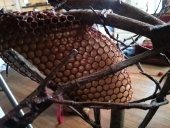
 3
3




 4
4




Dr Leo Sharashkin
Beekeeper and Editor
HorizontalHive.com




Iterations are fine, we don't have to be perfect
My 2nd Location:Florida HardinessZone:10 AHS:10 GDD:8500 Rainfall:2in/mth winter, 8in/mth summer, Soil:Sand pH8 Flat
 2
2




Leo Sharashkin wrote:I do have Varroa mites and small hive beetles in all my hives, but after years of coexisting with these pests natural has selected for the colonies that could not care less about them (that is, have developed good defenses that make any intervention by you unnecessary).
find religion! church
kiva! hyvä! iloinen! pikkumaatila
get stung! beehives
be hospitable! host-a-hive
be antisocial! facespace














|
That is so lame! You now get a slap from this tiny ad!
Regionally adapted Midwest Seeds for the rest of US
http://flyoverseeds.com
|


